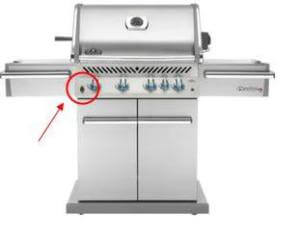Pizza on the grill? Of course!

If you don't want to heat up the inside of your home by running your oven because of the summer heat, but you still want a good pizza, you can very well do it on your BBQ. Here are our tips for cooking pizza on the grill!
The process is simple. First, you need to get a Napoleon pizza stone and place it on your BBQ grill. It is important that the stone heats up gradually along with the grill because a thermal shock could cause it to break.
You could just as easily cook one from scratch or unwrap a frozen pizza. It is recommended to prepare the pizza directly on a pizza spatula and then tranfser it directly on the hot pizza stone.
Once the pizza is ready and the BBQ is at the right temperature, place your pizza on the pizza stone, close the BBQ lid and let cook. To remove the pizza from the BBQ once it's done, the Napoleon pizza spatula will still be useful.
And now, voila!
The Maçonnex Experts
BBQ igniter problem? Maybe it's the battery...

With summer now well underway, barbecue has been used to its full potential for some time now. Often after a few years of use, the igniter (or ignition button) may appear to be defective, which is not necessarily the case. If you do not hear any sound when you press the ignition button, it may be a sign that the igniter has stopped working. There are three things that should be checked the moment you notice its defect.
First, check if the battery is still working. To reach the latter, you only have to unscrew the ignition button. If this still works, it is probably the second option: the receiver; that is, the receptacle in which the battery is stored. This, made of copper, can oxidize (produce verdigris). It is very important to clean up this verdigris as soon as you learn it if you want to continue enjoying your barbecue for a few more years. Use a small, porous brush so that no traces of oxidation are left in the receiver.
The third assumption concerns the wires which are located below the receiver of the battery. These could be disconnected. Please make sure that these connect the igniter to the electrodes.
The next time you're in the mood for a good barbecue, check your batteries and your receiver! Enjoy your meal!
How to prepare the surface before laying pavers or slabs

In order to properly prepare your floor for the upcoming installation of pavers or slabs, it will be necessary to proceed to three important steps; the excavation, the foundation and the bedding. Three steps will be presented to you for the realization of your project.
- Step 1 of 3: the excavation
Let's start with the first step of all, excavating the soil. First, you need to make sure that the area to be excavated is not cluttered with pipes or wires. If this is the case, you must contact the company concerned to remedy the situation. Once the wires and pipes have been checked, you will need to ensure adequate drainage by excavating your soil so that you have a slope of at least 2% (1/4 "per foot).
Then, make sure that the contour of the excavation protrudes from the surface to be paved by at least about 12 ". Also make sure that the depth is at least 12" depending on the nature of the soil. By doing this, you will ensure the stability and all the pieces will be well supported, both the edges and the center.
This is what completes this first stage of soil preparation.
- Step 2 of 3: the foundation

After you have excavated the soil, it is now time to move on to the second step of the preparation process: the foundation.
The first step is to properly spread and compact the 0-3 / 4 "stone in layers of 4". To facilitate the compaction, it is suggested to water the stone 0-3 / 4 ". It is even advisable to proceed to the compacting of the stone several times, this to ensure an adequate foundation. It is recommended to use a vibrating plate, a vibrating roller or a rammer (jumping jack).
This is what ends this second stage of soil preparation.
- Step 3 of 3: the laying bed

Once the excavation and the foundation of the soil are completed, all that remains is the laying bed: the last step and not the least.
First, spread between 5/8" and 1" of concrete sand or stone screen. Note that the bedding is reduced from 1 "to 5/8" in thickness due to the compaction carried out after laying the pavers.
Second, leveling the ground. Using two 1" diameter pipes and a straight board, level the concrete sand or stone screening. This is again a fairly important step, since a variation in the thickness of the concrete. bedding can cause deformation of the paved surface.
Lastly, be sure to do the sand compaction after laying the pavers, not before. Compacting the pavers with the vibrating plate later will allow the pieces to become embedded in the bedding.
There you go, this is what completes the ground preparation steps before laying your paver. If you ever missed any detail, you can always check with a Maçonnex expert or consult the installation guide on the Permacon site. There you will find several other explanations and pictures that will help you assimilate everything.



